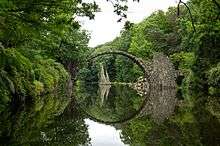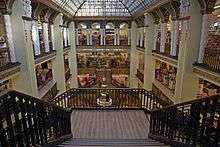Upper Lusatia
Upper Lusatia (German: Oberlausitz) is a geographic and historic region that is mostly located in modern-day land of Saxony in Germany. In this guide, it is used to refer to the territory of the Bautzen and Görlitz districts of Saxony, although what is referred to as Upper Lusatia by historians would usually include parts of what is now Dolnośląskie in Poland, as well as lands now belonging to the Czech Republic.
The Saxon Upper Lusatia is known for its picturesque hilly and mountainous landscapes covered with dense forests, as well as cities and towns with rich, long history. Many of the settlements in the region have been recorded as existing for over a thousand years and have played a vital role in the history of Saxony, Bohemia, Poland and Central Europe in general. The natural beauty of the region is also a major draw, and the region is a popular holiday destination for the nature-loving Germans.
Upper Lusatia is also the home of the Upper Sorbian ethnic minority in Germany. Sorbs use a Slavic language that is not immediately ralted to German, and it has an official status in Saxony. There are 40 000 active speakers of Upper Sorbian in Upper Lusatia, and many municipalities feature biligual (German / Upper Sorbian) signage. A related Lower Sorbian ethnic minority is mostly concentrated in southern Brandenburg
Regions and destinations
- The Bautzen district is the western part of Upper Lusatia, containing the historically important cities of Bautzen and Hoyerswerda.
- The Görlitz district is the eastern part of Upper Lusatia, bordering Poland. Historically, it used to blend seamlessly with what is now a part of Poland on the other side of the border-marking river Neisse (Nysa in Polish).
Cities

Note that many of the towns mentioned here have bilingual town signs; the name linked here is their German name with the Sorbian name mentioned in parenthesis where applicable
- 🌍 Bautzen (Budyšin) – cultural and political centre of the Lusatian Sorbs; lovely old town with many medieval towers
- 🌍 Hoyerswerda (Wojerecy) – one of the "socialist model cities" of East Germany, dominated by plattenbau buildings, however there is also an old town that is worth seeing; close to the Lusatian lake district
- 🌍 Kamenz (Kamjenc) – located in the Western Lusatian hill country, this old town is home to the famous German playwright Gotthold Ephraim Lessing
- 🌍 Bad Muskau (Mužakow), a spa town which contains half of the Muskau Park, a UNESCO World Heritage Site (the other half is across the border in Poland)
- 🌍 Görlitz – most populous city of the region; undestroyed during World War II and carefully renovated after the end of communism, Görlitz is one of the most beautiful demonstration pieces of architectural history in Germany: ranging from the Middle Ages to Art Nouveau
- 🌍 Herrnhut – origin of the Protestant-pietist Herrnhut Brethren church
- 🌍 Löbau
- 🌍 Zittau – close to the German-Polish-Czech border triangle and the small Zittau Mountains ridge
Other destinations
- 🌍 Lusatian lake district – giant strip-mining excavators once transformed this area into a "moon landscape" as lignite was East Germany's main source of energy; after the end of mining, it was recultivated as a recreational area with the gravel pits flooded to become dozens of clean lakes
- 🌍 Upper Lusatian Heath and Pond Landscape, UNESCO biosphere reserve – home to several protected bird, amphibia, mammal and insect species as well as rare plants; can be discovered on foot or by bike, and offers products of sustainable agriculture and fishing
- 🌍 Zittau Mountains – small mountain range (up to 793 m high) on the German-Czech border with picturesque rock formations, popular for hiking and winter sports
Understand
While Upper Lusatia has been linked to Saxony for centuries, it has maintained a distinct cultural identity. Parts of the region did not belong to Saxony until 1945, but were part of the Silesia province that was—except for this little piece—annexed by Poland after the Second World War. While the majority of inhabitants are ethnic Germans, the region's most particular feature is the existence of an indigenous, Slavic-speaking minority group: the Sorbs. Most of them are Catholic and regular church-goers, another distinctive feature in the otherwise Protestant and irrelegious Eastern Germany.
Talk
.jpg)
While the local population generally speaks German, Upper Sorbian—a Slavic language—is in active usage, too. People speaking Upper Sorbian will be able to understand Czech and, to a lesser extent, Polish, while speakers of both those languages may be able to understand spoken and written Upper Sorbian to some extent.
Get in
By plane
There is no airport in Upper Lusatia. The nearest major airport is in Dresden (DRS IATA), airports in Leipzig (LEJ IATA), Berlin (BER IATA for all airports, SXF IATA and TXL IATA for the two individual airports), Wrocław (WRO IATA) and Prague (PRG IATA) are also within 1.5 to 3 hours of the region.
By train
There are no intercity trains serving Upper Lusatia. The closest station with intercity service is Dresden. From there "regional express" and local trains connect to Bischofswerda, Bautzen, Görlitz, Zittau, Hoyerswerda, Königsbrück and Kamenz.
By bus
- See also: Intercity buses in Germany
Some Intercity buses connect the area to other parts of Germany, mostly Berlin. Flixbus has a near monopoly and is the only company serving the area.
By car
Upper Lusatia is intersected by the A4 motorway Dresden–Görlitz–Wroclaw.
Get around
In all regional and local trains and buses, ZVON combined tickets are valid. EURO-NEISSE tickets even allow you to cross the border to the adjacent parts of Poland and the Czech Republic.
See


- Muskau Park (or Fürst-Pückler-Park) in Bad Muskau – the largest English-style landscape garden in continental Europe, carefully designed and rich in variety, with several castle and manor buildings, UNESCO World Heritage site
- Azalea and Rhododendron park Kromlau (6 km west of Bad Muskau) – another beautiful landscape garden with artificial rock formations, caves, grottos, pyramids and exotic plants
- Muskau forest railway – a historical narrow-gauge railway, connecting Bad Muskau, Krauschwitz, Weißwasser and Kromlau
- Nochten boulder park (20 km southwest of Bad Muskau)
- Görlitz old town – barely any other city in Germany tells you its story like this one, as historic buildings from almost all eras have survived, from late Gothic, Renaissance and Baroque town houses to complete 19th century quarters and Art Nouveau buildings; the town was left almost undamaged by World War II and restored in an exemplary manner after the end of communism. Therefore it is often used as a filming spot for period movies.
- Bautzen old town – still has a mostly medieval face, with a cathedral that is simultaneously used by the Catholic and Lutheran church, Ortenburg castle and many old towers (therefore Bautzen's epithet as the "city of towers")
- Kleinwelka labyrinth and dinosaur park (5 km northwest of Bautzen)
- "House of thousand ponds" – visitors information centre of the Upper Lusatian biosphere reserve, in the middle of the heath and pond landscape (16 km northeast of Bautzen)
- "Krabat" mill, Schwarzkollm (8 km west of Hoyerswerda) – site of a well-known folk legend of a poor country boy who comes to a mysterious mill looking for work. After pledging as an apprentice, he finds out that its shadowy "Master" is in fact a dark magician. Having tried to escape, the apprentices are transformed into birds. In the end, they are redeemed by the power of love. The mill houses an exposition on the tale, related novels and films, and informs about Sorbian language and customs, mainly targeting children and youths. There is a themed theatrical festival in July of each year.
Do

- Hiking and winter sports (mostly cross-country skiing) in the Zittau Mountains
- Cycling tours along the Oder-Neisse trail and other regional cycling paths
- Water sports in the Lusatian lake district
- Swimming, sauna and spa at Erlebniswelt Krauschwitz
- Watch the particular Sorbian Easter riding processions
Eat
The regional cuisine, at least in the eastern part of the region, is quite distinct from the rest of Saxony. It reflects Silesian, Sorbian and Bohemian (Czech) influences. Typical dishes include Teichelmauke (or Deichelmauke; mashed potatoes with beef, broth and sauerkraut), Stupperle (a kind of potato dumplings, as a side dish) or elderberry soup.
A special product of the region is linseed oil that can be eaten with a breadroll and sugar, or with curd and potatoes. Another widely known product is Bautzen mustard. During the pre-Christmas season, you should try Pulsnitzer lebkuchen (gingerbread).
Drink
The region's major brewery is Landskron of Görlitz. A local beer specialty is Lausitzer Porter from Löbau, a very malty, almost sweet black beer, that is also available with cherry flavour.
Stay safe
The border area with Poland and the Czech Republic is said to have a somewhat higher crime rate, when it comes to burglary and car theft, but this is rather a nuisance to locals than a danger to tourists. Lusatia is one of the few regions of Germany that has a population of wild wolves, that are however harmless to humans (while local farmers complain about wolves killing their cattle).
Go next
- Saxon Elbland with the world-famous state capital Dresden
- Southern Brandenburg with the Spreewald meadows and forests
- Cross the border to either Dolnośląskie (Poland) or North Bohemia (Czech Republic)